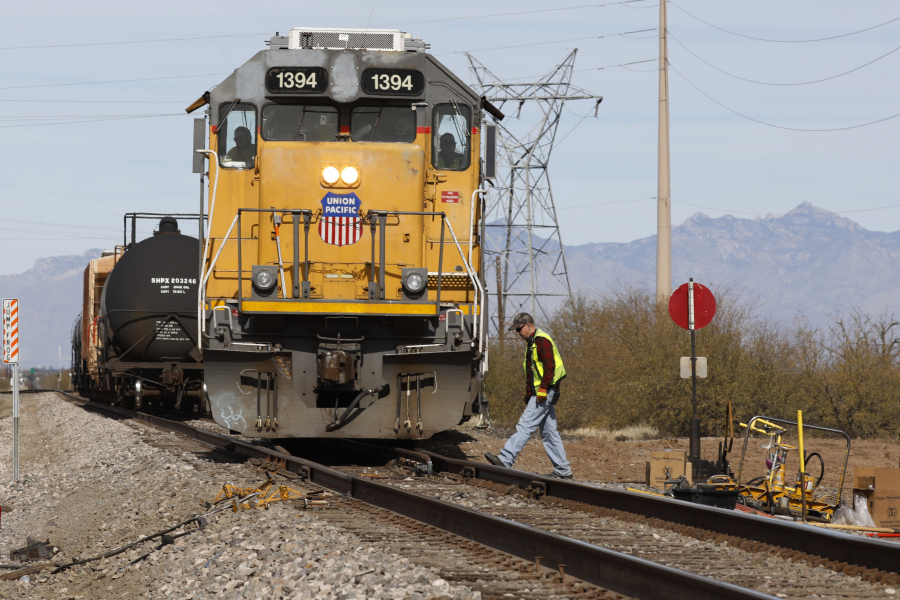OMAHA, Neb. (AP) — Union Pacific will renew its push for one-person train crews later this summer when the railroad tests out the idea of having a conductor in a truck respond to problems on trains in Nebraska and Colorado.
The railroad will continue using two crew members on its trains during the test, but officials say this could bolster their case in future negotiations for cutting crew size if it is successful.
UP’s Jason Pinder confirmed the pilot program Monday when he testified against a proposed Kansas rule that would require two-person crews. The Omaha, Nebraska-based railroad has long been a leading proponent in the industry’s push to go down to one-person crews.
This plan had to be shelved earlier this year after the Transportation Division of the International Association of Sheet Metal, Air, Rail and Transportation Workers union that represents conductors opposed it. But that union later agreed to let Union Pacific test out ground-based conductors as long as it maintained current crew sizes and agreed to drop ongoing negotiations over reducing crew size. Even though UP abandoned its current proposal to eliminate conductors on trains, the railroad can reintroduce the idea in the next contract negotiations that begin in 2025.
Union officials say there has been no change in SMART-TD’s longstanding opposition to the idea of eliminating the second person in the cab of a locomotive because of safety concerns. In fact, the union’s Ty Dragoo testified Monday that “We’re huge proponents” of the proposed Kansas rule.
If that state’s regulators approve, Kansas would join at least nine other states that have passed laws requiring two-man crews. The others are California, Wisconsin, Arizona, West Virginia. Minnesota, Washington, Nevada, Colorado and Ohio. Railroad safety has been a key focus nationwide this year in the wake of a fiery February derailment in eastern Ohio that forced evacuations and created lingering health concerns and several other rail crashes.
The railroads strongly oppose state laws on their operations and usually challenge them in court because they argue that the federal government should be the only one to regulate the industry to ensure there is a uniform set of rules nationwide. The Federal Railroad Administration is also currently considering a proposed rule that would require two-person crews, but it’s not clear when they will act on the rule.
Members of Congress have also proposed requiring two-man crews as part of a package of rail reforms drafted after the East Palestine, Ohio, derailment. That bill garnered bipartisan support initially but hasn’t yet been debated on the floor of the Senate, and it faces uncertain prospects in the Republican-controlled House where most lawmakers are reluctant to approve new regulations.
The pilot program will run in western Nebraska between North Platte and Morrill and in Colorado and Wyoming between Denver and Cheyenne starting in August and September. The railroad’s idea is to test out how quickly a conductor in a truck can respond to any problem compared to how quickly a conductor on the train will be able to walk back along the train to find an issue. UP still has to work out exactly how big of a territory a ground-based conductor might cover.
Railroads have fought any crew size requirement because they say there isn’t enough data to show operating trains with one crew member would be riskier, and they argue that railroads have become safer in recent decades even as crews shrank from five to the current standard of two. The railroads have argued that modern technology — particularly the automatic braking system railroads were required to install in recent years — makes the conductor unnecessary on a train and executives believe that moving conductors off of trains would improve their quality of life by giving them more predictable schedules and keeping them from going on the road.
While all the major freight railroads continue to use two-person crews, a number of short-line railroads have already been using one-person crews for years. Chuck Baker, the president of the American Short Line and Regional Railroad Association, testified at the Kansas hearing Monday that many of those smaller railroads have also found other benefits of having a conductor based in a truck such as having them adjust switches ahead of a train or go ahead to visit with customers before a train arrives.
But all the rail unions have long opposed moving conductors out of locomotives, arguing they help monitor track conditions and radio communications while ensuring that engineers remain alert and respond to any emergencies or mechanical problems on the train. In the case of a derailment or collision, conductors are the first ones to respond before any additional help can arrive.
The unions say the value of having a conductor onboard has been demonstrated time and time again including during a fiery 2013 derailment near Casselton, North Dakota, when the conductor was able to help separate undamaged tank cars filled with crude oil from the rest of the train so they could be pulled away from the fire.
Critics of the idea of moving conductors out of the locomotive cabs have also raised practical questions about whether a conductor driving a truck would even be able to reach a train in remote locations where no roads are near the tracks. Plus, a conductor in a truck could be delayed in traffic.
A major highway runs next to the tracks in Western Nebraska that UP plans to test, but it may be harder for a conductor in a truck to reach trains in the mountainous territory of Colorado.



